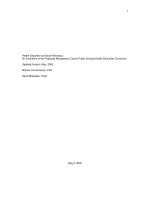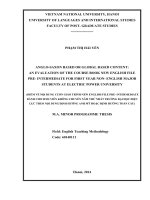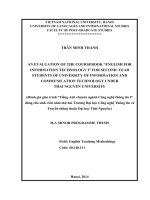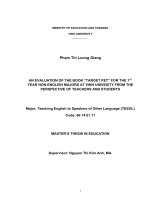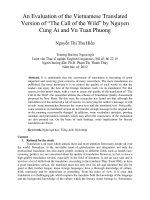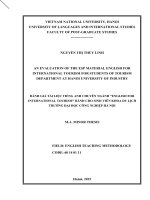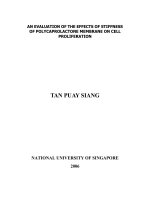An evaluation of the america vietnam joint education program at doan thi diem secondary school
Bạn đang xem bản rút gọn của tài liệu. Xem và tải ngay bản đầy đủ của tài liệu tại đây (1.07 MB, 65 trang )
1
VIETNAM NATIONAL UNIVERSITY, HANOI
UNIVERSITY OF LANGUAGES AND INTERNATIONAL STUDIES
FACULTY OF POST- GRADUATE STUDIES
TRẦN THỊ TUYẾT
AN EVALUATION OF THE AMERICA-VIETNAM JOINT EDUCATION
PROGRAM AT DOAN THI DIEM SECONDARY SCHOOL
ĐÁNH GIÁ CHƯƠNG TRÌNH HỢP TÁC GIÁO DỤC VIỆT –MỸ TẠI TRƯỜNG
TRUNG HỌC CƠ SỞ ĐOÀN THỊ ĐIỂM
M.A Minor Programme Thesis
Field: ELT Methodology
Code: 601410
HANOI, 2010
2
VIETNAM NATIONAL UNIVERSITY, HANOI
UNIVERSITY OF LANGUAGES AND INTERNATIONAL STUDIES
FACULTY OF POST- GRADUATE STUDIES
TRẦN THỊ TUYẾT
AN EVALUATION OF THE AMERICA-VIETNAM JOINT EDUCATION
PROGRAM AT DOAN THI DIEM SECONDARY SCHOOL
ĐÁNH GIÁ CHƯƠNG TRÌNH HỢP TÁC GIÁO DỤC VIỆT –MỸ TẠI TRƯỜNG
TRUNG HỌC CƠ SỞ ĐOÀN THỊ ĐIỂM
M.A Minor Programme Thesis
Field:
ELT Methodology
Code:
601410
Supervisor: Phùng Hà Thanh, M.Ed
HANOI, 2010
6
TABLE OF CONTENTS
INTRODUCTION ..................................................................................................................10
1. Rationale for the study .......................................................................................................10
2 Aims of the study..................................................................................................................11
3. Scope of the study ...............................................................................................................12
4. Methods of the study...........................................................................................................13
5. Significance of the study .....................................................................................................13
6. Overview of the rest of the paper ......................................................................................14
CHAPTER ONE: LITERATURE REVIEW .......................................................................15
1.1 Conceptions of program evaluation ............................................................................15
1.1.1 Definition of program evaluation .........................................................................15
1.1.2 Purposes of program evaluation ...........................................................................16
1.1.3 Program evaluators ...............................................................................................17
1.2Overview of Immersion program .................................................................................18
1.2.1
Definition of Immersion program .................................................................18
1.2.2. Models of immersion program ............................................................................20
1.2.3 Characteristics of immersion programs ..............................................................24
1.2.4 Overview of evaluation of immersion programs .................................................28
1.3 Chapter summary .........................................................................................................30
CHAPTER TWO: METHODOLOGY .................................................................................31
2.1 Research design .............................................................................................................31
2.2. Setting of the study ......................................................................................................32
2.3 Participants....................................................................................................................33
2.4 Data collection instrument ...........................................................................................34
2.4.1 Justification for the use of semi- structured, open- ended interviews...............34
2.4.2 Description of interview schedule .........................................................................34
2.4.3 Procedure of data collection..................................................................................34
2.5 Data analysis ..................................................................................................................35
2.6 Chapter summary .........................................................................................................36
7
CHAPTER THREE: RESULTS, FINDINGS, RECOMMENDATIONS .........................37
3.1 Results of the teacher interviews .................................................................................37
3.2 Result of student interviews .........................................................................................43
3.3 Major findings ...............................................................................................................48
3.3.1 The strengths of the program ...............................................................................49
3.3.2 The weaknesses of the program ............................................................................50
3.4 Recommendations .........................................................................................................52
3.5 Chapter summary .........................................................................................................54
CONCLUSION .......................................................................................................................55
REFERENCES........................................................................................................................57
APPENDICES ..........................................................................................................................59
APPENDICE 1: TEACHER INTERVIEW SCHEDULE ..................................................60
APPENDICE 2: STUDENT INTERVIEW SCHEDULE ...................................................61
APPENDICE 3: CÂU HỎI PHỎNG VẤN HỌC SINH ......................................................62
APPENDIX 4: CONTENTS OF THE READING STREET BOOK .................................63
APPENDICE 5: CONTENTS OF THE SCIENCE BOOK ................................................66
APPENDICE 6: CONTENTS OF THE MATH BOOK .....................................................67
8
LIST OF ABBREVIATIONS
DTD
:
Doan Thi Diem
L1
:
first language
L2
:
second or foreign language
MOET
:
Ministry of education and training
US
:
United States
WTO
:
World Trade Organization
9
LIST OF FIGURES AND TABLES
Figure 1: Model of early total immersion program in Canada
Figure 2: Model of middle immersion program in Canada
Figure 3: Model of late immersion program in Canada
Table 1: A summary of the strengths and the weaknesses of the program
10
INTRODUCTION
1. Rationale for the study
In recent years, especially after Vietnam’s entry into the WTO and the becoming of English
as an international language, there has been an unprecedented increase in English learning.
Along with this surge in interest for English language learning is the increasing demand for
native speakers and foreign educational program. In addition, the Education and Training
Ministry has cooperated in delivery of foreign language courses in Vietnam. One of the
priorities in Vietnam is “overseas studies at home” hence, there have been independent or
joint- venture schools established to implement such cooperation program such as Hanoi
International School, UN School, South International School, Grammar school- Ho Chi Minh
City and Japanese primary School. According to “Sai Gon Giai Phong Online”, the number of
students enrolls the international school or foreign education program has been increasing the
past two years. For example, in 2009 there were only 200 students enrolling the Asian Pacific
College. This year, 2010 this number has raised up to 1000 students; at American
International School, there were less than fifty students taking part in the program in 2009 but
in 2010, this number has doubled. More and more parents want their children to learn with
native speakers of foreign languages because they believed that this is the best way to learn
foreign languages.
The increasing demand for learning at international schools leads to the increase in the
number of this type of schools. So far there have been thirty international schools established
regardless of private schools which have several international classes. Doan Thi Diem is one
of the schools which have applied the model of international schools. The school has
cooperated with schools in America and Singapore to form joint education programs in which
students have chance to follow two educational curriculum simultaneously namely
Vietnamese curriculum and oversea curriculum. The joint education program involves using
an additional language for teaching and learning both language and content. In fact, this is an
adaptation of immersion program in which two (or more) languages are used for learning and
teaching both language and content. One of the languages is students’ mother tongue and the
other is a second or foreign language which is not the subject to be taught but the medium of
instruction to teach other subjects such as math, science or history.
11
Immersion program originated in Canada in the 1960s, is one of the most thoroughly
researched areas of second language learning. Evidence and concern and interest in
immersion program are shown through a large body of research studies on different aspects of
immersion program. The effects of immersion program on second or foreign language
learning have been carefully examined through research done by Genesee (1984), Lambert
(1984), Swain (1980), Swain (1984), Swain (1996), Genesee (2005), Zhou (2008). These
researches show that immersion program has positive effects on language learners. Despite
such a wealth of research data in the effectiveness of the immersion program, research
implications can not be applied in every context due to different social- cultures. Seeing the
benefits of the immersion program in language learning, the educators have applied the
immersion program in international schools in Vietnam for the past few years. However, there
has been no research conducted to investigate the effectiveness and the results of the
immersion program in Vietnam in general and at Doan Thi Diem School in particular. The
fact that, every program needs evaluating from time to time in order to improve the quality of
teaching and learning for all learners within an educational system. This is to ensure that the
teaching is on tracks and that learners are learning what they are supposed to learn so that the
desired results can be attained. The above reasons have made the researcher conduct this
study.
2 Aims of the study
The study aims to evaluate the America-Vietnam joint education program at Doan Thi Diem
Secondary School from the perspective of the teachers and the students. Specifically, the
research focuses on the strengths and weaknesses of the program. These aims could be
achieved by seeking answers to the following six research questions:
From the perspective of the teachers:
1) What are the expectations of the program?
2) What are the strengths of the program?
3) What are the weaknesses of the program?
12
From the perspective of the students:
4) What are the expectations of the program?
5) What are the strengths of program?
6) What are the weaknesses of the program?
3. Scope of the study
Every evaluation is based on a framework which determines both the strategies for gathering
data and the extrapolation of judgments from these. In some evaluation processes, this
framework is either implicit or explicit, but increasingly the exigencies of openness and
accountability in such processes require that criteria be clearly stated. According to DudleyEvans and St. John (1998), in the evaluation process, the evaluator must take evaluation
criteria into account before any evaluation takes place. Criteria for evaluation depend on what
is being evaluated and why they need to be evaluated.
This research was conducted to evaluate the America- Vietnam joint education program at
Doan Thi Diem secondary school from the teachers’ and students’ perception. The researcher
focused on investigating the strengths and weaknesses of the program after a year
implementation. Strengths of the program in this study are identified as the factors of the
program that meet the needs of teachers and students. As a result, teachers and students can
reach the achievements. And the weaknesses of the program are the factors of the program
that do not meet the needs of teachers and students. As a result, teachers and students can not
reach the achievements. In so doing, first and foremost, the researcher investigated the
expectations of teachers and students in terms of facilitators which include environment,
facilities, management, methodology and content; and their expectations of achievements.
Based on this framework of facilitators and the achievements at the end of the first year
implementing, the strengths and weaknesses of the program from the perspectives of teachers
and students would be presented. Then the researcher would figure out the strengths and
weaknesses of the program.
13
4. Methods of the study
This case study was conducted at class 6M, Doan Thi Diem secondary school. With a view to
support the research with varied and valid data, the qualitative research was used together
with the quantitative one. The main tool of the research to collect data is semi- structured
open- ended interviews with teachers and students. The interviews were conducted with two
native teachers teaching in the program of the school year 2009-2010 and with thirty- one
students of class 6M. The interviews were conducted after one year of teaching and learning
in the program.
5. Significance of the study
After finishing the study, the researcher hopes that this case study can have some practical
contributions.
Firstly, this research can provide useful information for the stakeholder and supervisors of the
program. The joint education program is a new model in education in Vietnam and it is
quickly widened at not only Doan Thi Diem secondary school but also many other private
schools. This study involves specific information that is definitely needed to be taken into
consideration. The study is the description of the teachers’ and students’ perception of the
program. Through the insiders’ view, the stakeholders and supervisors can have a better
understanding of the strengths and weaknesses of the program. Then they can figure out
methods to enhance the outcomes of the program. Furthermore, from the weaknesses
perceived by teachers and students, some solutions can be applied to minimize the
weaknesses of the program.
Secondly, the teachers can have a full view of their teaching process. The students’ opinion is
a powerful tool for teachers to form a better reflection of their teaching. The teachers can base
on this to apply the most effective teaching methods to improve the quality of teaching and
learning process. Finally, this study once being completed can be a valuable source of
information for further related researches.
14
6. Overview of the rest of the paper
Besides the first part which gives general introduction and the final part as the concluding
segment, the research is divided into the following sections:
-
Chapter one which traces back the literature review in the field of evaluation of
educational program as well as an overview of immersion programs.
-
Chapter two which presents the methodology of the research.
-
Chapter three where the data are presented, the findings come up with the
recommendations built upon the basis of the evaluation in the previous chapter.
15
CHAPTER ONE: LITERATURE REVIEW
This chapter offers a review of the literature related to program evaluation and an overview of
immersion programs. In each section, the definition, explanation of the key terms is presented
together with the studies over the world.
1.1 Conceptions of program evaluation
1.1.1 Definition of program evaluation
Evaluation is in fact, a very natural activity that most people do; something that is very much
of the daily existence. However, they are not always aware of it. For example, when someone
is commented on his new suit or his behavior, or such, he is being evaluated. In this sense,
evaluation is the result, the realization of how people view something. Therefore, “making
evaluate judgments is a feature of social life” ( Rea-Dickins & Germaine, 1992 p.4)
Nevertheless in educational context “evaluation is a purposeful activity that includes the
collection of relevant information, interpretation of that information and making decisions
about teaching and learning” ( Genesee & Upshur,1996, p.256).
Evaluation from the viewpoint of Keily and Rea- Dickins has more meanings in language
programs. It “refers to the judgment about students by teachers, and by external assessors, the
performance of teachers by students, program managers, and institution; and programs,
departments and institutions by internal assessors, external monitors and inspectors.” ( Keily
& Rea-Dickins, 2005, p.5). Through program evaluation, the relationship between different
program components can be revealed, the procedures developed by the program participants
can be seen, and the processes and the outcomes used to show the program value and enhance
this value developed.
When the term evaluation is used, it is not exclusively referred to testing, as shared by
Aldeson (1986:5) evaluation is the process of seeking to establish the value of something for
some purpose, test is an instruments for gauging learning outcomes” ( Alderson, 1986 as cited
in Brown and Rodgers, 2002, p.227). Evaluation includes all the practice and instruments
involved in gathering and compiling the data necessary to make judgments about the value of
language course or program; this may or may not include students’ test results. More
16
specifically in using the phrase language program evaluation, it is meant “the systematic
collection and analysis of all relevant information necessary to promote the improvements of
all curriculum and access its effectiveness and efficiency as well as participants’ attitudes
within the context of a particular institutions involved. (Brown 1989:223 cited in Brown &
Rogers, 2002, p.227)
In the words of Lynch (1996, p.6), evaluation is also defined as the systematic attempt to
gather information in order to make judgments or decisions. As such, evaluative information
can be both qualitative and quantitative in form and can be measured through different
methods such as observation or the use of unstructured interview or the administration of
pencial or paper tests. Sharing this definition of evaluation, Tancy (2005) states that “program
evaluation is a process of collecting information and making judgments about how the
program is currently operating to guide decisions for future planning. He also added that
evaluation is an integral part of program planning and is the key to continuous improvements
in schools”
1.1.2 Purposes of program evaluation
There are a range of motivations or purposes for evaluating. Scriven (1967) distinguishes two
main purposes for evaluating: formative and summative evaluation (as cited in Lynch, 2003).
The former occurs while the program is being implemented and developed. The goal of this
type of evaluation is to recommend changes for improving it, and towards this end it focuses
on program processes. Typically the outcome of a formative evaluation is numerous smallscale recommendations for change. The later takes place at the end of a program’s natural
term or cycle with a view to make judgment about the program worth, whether it has
succeeded in meeting its objectives or not. Accordingly, the outcome of the summative
evaluation is a formal report to be used in large scale decisions such as whether to continue
funding the program or not.
In fact, most evaluations represent a combination of formative and summative. If evaluators
are interested in judging the ultimate worth of a program, they must explain why it is or is not
working and then recommend for improvement. Discussing the distinction between formative
and summative evaluation, Rea-Dickins and Germain (1992) view this distinction as
17
confirming versus innovating. That is sometimes motivation for evaluation is to decide
whether or not the current practice (program) is doing what it should; at other times
motivation is to bring about innovation or change in those practices.
1.1.3 Program evaluators
The next point needs considering here is who evaluates the program. According to Low( 1987)
there are different perspectives could offer evaluation, namely the Learners, the Parents, the
Curriculum Committee Principals, the Teacher trainer, the Inspectors, the Educational
researcher .(as cited in Rea-Dickins & Germain, 1992, p.32). In Weiss’s view, the evaluation
as a process of determining the worth of the program has to engage with different
perspectives.( Weiss, 1986 as cited by Keily and Rea-Dickins, 2005) Then he grouped them
into two categories which he called stakeholders: one group is members of groups affected by
the program and another is members of group who make decisions about future of the
program. The former includes practitioners such as teachers and clients such as students.
Their stakes relate to modes of participation and investment. The later comprises policy
makers and program managers whose stakes are likely to be in the area of resourcing and
strategic management.
Often evaluation is done by administrators or supervisors such as principals, inspectors, and
subject advisors but for teachers to be real professionals as shared by Brophy and Good (1994)
they must learn from their own teaching to reflect on it afterwards and to engage in
professional development activities with colleague. (as cited in Alausa, Y.A, 2000). One of
the most popular methods to investigate what is going on during actual teaching is the use of
teachers’ and students’ perception. According to Fraiser (1994) students have a good vantage
to make judgments about classrooms because they have encountered many different learning
environments and have spent time in classroom to form accurate impressions. Therefore,
students should at least be able to say what they like and do not like ( Fraiser, 1994 as cited in
Alausa, Y.A, 2000).
Discussing evaluation program through perception of teachers and students, Dillion and
Peterson (1986) stated that although administrators have considerable responsibility for
evaluation, effective administrators involves teachers and students in this process and use
18
their views to good vantage ( Dillion & Peterson, 1986 cited by Alausa, Y.A, 2000). Teachers
are insiders who undertake the program and that is teachers who want to improve the quality
of teaching and learning in their own classrooms. In addition, students are the recipients of the
teaching process, hence students’ perception and observation can work in practice and
become part of exploratory studies ( Eken, 1999; Sidhu, 2003 as cited by Amad, F & Aziz, J,
2009). Students’ perception contributes as much to the teaching- learning process by
providing suggestions and directions for teachers’ future improvement. Teachers can use the
information or comments gathered from the students to polish their methodology and style of
teaching and look for ways to improve.
The recent study presents evaluation from the teachers and students who are affected by the
program. Research on students’ thinking and perceptions functions as a mirror, can be used by
both teachers and students to reflect upon their teaching and learning, hence enhancing their
understanding of teaching and increase its outcome. Teachers are those who are implementing
the program, their views of the teaching and learning process can help them made
improvements to better the quality of the program.
1.2Overview of Immersion program
1.2.1 Definition of Immersion program
By the mid 1960s, it was already apparent to the English speaking population of the Canadian
province of Quebec which would require high level of proficiency in French. At that time
there was an increasing emphasize the importance of French as “langue de travail“. However,
a large number of English speakers who had studied French at school knew little of the
language which was not qualified enough to work in French and to socialize with French
speakers because the classes focused on grammar, memorization and drills.
Immersion language education was born out of grassroots initiatives prompted by parents
whose concern was that the level of second language or French attained by children would be
sufficient enough to function in bilingual areas of Canada. Then, the first immersion program
was French immersion program in 1965 in St. Lambert, Montreal. A program in which from
the first day of school in kindergarten, the unilingual English speaking children would be
19
instructed in French thus the children first learn to read in French and only in grade two, three
or four were first language literacy skills introduced into the curriculum. Other subjects were
also introduced in English in later grades so that by grade six about half of the curriculum was
taught to English and half in French. By the late 1960s, the rest of Canada was becoming
aware of the value the immersion program had and the program had been spread to other parts
of Canada. The first model as mentioned above is most typically introduced. Later there were
some variations to meet the demands of the parents. Since then immersion program has been
used to teach second or foreign language.
The concept of Immersion schooling was based on a very important and fundamental premise
that people learn a second or foreign language (L2) in the same way as acquire their first
language (L1). Immersion program seeks to provide an environment in which students are
exposure to L2 in its natural form and where they are socially motivated to communicate.
According to Krashen (1984), students acquire L2 only when they receive comprehensible
input, not when learners are memorizing vocabulary or completing grammar exercises. It is
assumed that methods that provide students with more comprehensible input will be more
successful. Students acquire a language when they understand message in that language,
hence “comprehensible subjects matter teaching is language teaching” (Krashen, 1984 as
cited in Celce- Murcia, 2001, p.304).
There are several defining features of immersion language education model. First of all,
immersion education is defined as a type of bilingual education in which L2 is used along
with the students’ L1 for curriculum instruction during some parts of the students’ elementary
and/ or secondary schooling (Genesee, 1984). However, Lambert (1984) states that there is a
significant difference between immersion program and bilingual education program. In
immersion program, no bilingual skills are required of the teacher who plays the role of a
monolingual in the target language and never switches languages, reviews materials in the
other languages or otherwise uses the child’s native language in teacher-pupil interaction.
Therefore, in immersion program, bilingualism is developed through two separate
monolingual instruction routes.
Snow (2001) claims that “the immersion model of foreign language education is perhaps the
prototypical content-based approach”. (Snow, 2001 as cited in Celce-Murcia, 2001, p.305)
20
Content- based approach in her interpretation is the use of subject matters which consist of
topics or themes based on students’ interest or need in an adult setting or the subjects taught
in elementary school classes. Nevertheless, the content-based approach is more utilized in
teaching English for specific purposes in order to provide second language students with
types of academic tasks that they will need at school, college or university. Immersion
program as defined by Met (1993) is a method of foreign language instruction in which the
regular school curriculum is taught through the medium of the language. The foreign
language which is not taught explicitly as a language subject rather is the vehicle for content
instructions.
Though teachers and educators have different ways to define immersion program, most of
them share the view of immersion program as educational program in which two or more
languages are used for academic instructions. One of the languages is students’ home
language (L1) and the other is a second or foreign language (L2). The immersion approach
has characteristic of other current approaches to second language teaching such as integrated,
content-based or functional instruction. These new approaches contrast with traditional
methods of second language teaching in which teachers focus on direct teaching of
vocabulary, grammar or conventional patterns and correction is given whenever students
make mistakes. Nevertheless, immersion approach emphasizes the importance of using the L2
as a vehicle for teaching content and creates a condition for second language acquisition
occurring by a product of academic writing.
1.2.2. Models of immersion program
There are several types of immersion programs that differ along two dimensions: age of the
second or foreign language instruction and intensity of the second or foreign language
instruction.
In terms of age of initiation, programs can be classified as early immersion (the L2 is
generally used at the beginning of kindergarten or grade one), middle or delayed immersion
(onset of instruction in the L2 begins in the middle elementary grades, usually grade four) and
late immersion (begins at the end of elementary school or the beginning of secondary school).
As far as intensity of foreign language is concerned, immersion programs are divided into two
21
types: total and partial immersion program. The former is characterized by the use of L2 to
teach entire curriculum. The later is identified by the program delivering less than one
hundred percent (at least fifty percent) of the curriculum through L2. However, the total
immersion program only occurs at first three years of early immersion or late immersion
program. Partial immersion is the most model used by schools. Therefore, in the following
part a description of the three models of immersion program: early, middle and late are
presented in detail.
1.2.2.1 Early immersion
Early immersion programs start in kindergarten or grade one when students are about five
years old. There are early total immersion and early partial immersion. Figure 1 is an example
of a popular early total immersion program in Canada.
In early total immersion program, L2 is used as the medium of instruction during the first
three or four grades; the exact number of grades during which the L2 is used exclusively
varies among school districts. The students’ L1 is introduced as a medium of instruction in
some schools in grade two and in other schools; it is delayed until grade four or even later.
When it is first introduced into the curriculum, the students’ L1 is used to teach language arts.
In successively of higher grades, the L1 is used to teach more academic subjects such as
mathematics and science. The same subjects are never taught during the same year in both
languages. The use of the L1 during the first grade of the program (grade five and six) varies
from as little as twenty percent of total instructional time to sixty percent or seventy percent,
depending on the school. As much as possible, different teachers are used for teaching
through the L1 and L2, and the teachers who teach the L2 have native or native like
proficiency in the target language. Immersion teachers often present themselves as
monolingual, this is done in order to encourage the students to use the L2 as much as possible.
At the secondary school level, early immersion students are offered to select academic
courses in the L2; these courses are taught by teachers with specialized training in these
subjects. This phrase of the program is important because it allows students to maintain and
further develop their L2 skills. The courses offered in secondary school are content- based
courses such as history or geography and language based courses such as literature, drama, etc.
22
Figure 1: Model of early total immersion program in Canada (Genesee, 2005)
In early partial immersion programs, approximately half of the instruction in all elementary
grades is presented through the L2 and half through the L1. Different subjects are taught
through each language from the beginning, in other words, the same subject is never taught in
both languages during the same grade. Moreover, the teacher never (or almost never)
translates information that he/she presents in the L2 into the L1 so that students can
understand it more easily. This problem with this strategy is that students come to rely on
translation to understand classroom instruction and they turn off when the L2 is used. One
exception to the one-language/ one subject rule is language arts which is taught by both
languages (by different teachers, where possible). In secondary school, optional language
based or content- based courses are taught using the L2. The number and types of such
courses available to students depends on the school and the availability of teachers.
1.2.2.2 Middle immersion
In these programs, students receive instruction through their L1 in kindergarten until the
middle grades (grade four or five). Figure 2 is an example of middle immersion program.
During these grades, the students frequently receive thirty to sixty minutes per day of direct
L2 instruction to prepare them for immersion in the L2. The use of L2 as a medium of
academic instruction is delayed until the middle elementary grades, usually grade four (when
students are at about nine or ten years old). In grade four to six, the end of elementary school,
approximately half of the curriculum instruction is presented in the L2 and the remainder in
the L1, exact proportions differs from district to district.
23
Figure 2: Model of middle immersion program in Canada.( Genesee, 2005)
In secondary school, the students receive some academic instruction through their first
language and some through their second language. The amount of instruction they get in each
language varies somewhat from school to school.
1.2.2.3 Late immersion program
Late immersion programs usually begin in the first year of secondary school when the
students are about twelve years of age. An example of late immersion program is shown by
figure 3.
Figure 3: Model of late immersion program in Canada. (Genesee, 2005)
24
The students have had some prior L2 instruction; the amount varies depend on the school
district but is often forty to sixty minutes per day from grade one. Such prior exposure is
necessary if the students are to make successful transition to schooling in the L2 in secondary
school. The L2 is used as the primary medium of academic instruction for one or two yearsall academic subjects, except L1 language arts, are taught in the L2 by native or native like
speakers of the language. The curriculum during this time is essential the same as that in a
regular L1 school program; the difference being that academic subjects are taught in the L2.
As early immersion alternatives, the students are required to address all classroom comments
in the L2 and all of their reading and written assignments in their academic classes are done in
the L2 as well.
1.2.3 Characteristics of immersion programs
1.2.3.1 Objectives of immersion programs
Immersion programs, first introduced in 1972 as a way to incorporate intensive second
language education into public elementary schools have gradually spread widely in Canada,
United States of America, Hong Kong, China, Japan and are now viewed by educators and
parents as a highly effective way of teaching foreign language to children.
Immersion programs promote proficiency in the L2 by teaching academic subjects through
the medium of the L2. Immersion teachers use only the L2 for instruction during all or
significant portions (at least fifty percent) of the school day. Students inductively learn the
language that is part of their everyday social interaction with their teachers and other students,
in other words students learn the language by using it in school during social and academic
activities. Although immersion teachers use the L2 at all times during designated L2 periods,
immersion students continue using their first language during the beginning of the program
with one another and with the teacher- usually during the kindergarten years in an early
immersion program. The students begin to make all of their comments in class to one another
and to their teachers in the L2 once they acquire basic proficiency in it, on the assumption that
using the language will promote its acquisition. Because the primary focus in immersion class
is on meaningful communication. L2 learning in immersion is often incidental to academic
25
learning and social interaction that make up normal classroom life. Students acquire the
language inductively using their natural language learning abilities.
While the bulk of immersion programs exist in Canada and the United States, the model has
been also implemented in international setting such as Hungary, Spain, Finland, Korea, China
and Japan. According to Cloud, Geneese and Hamayan (2000) despite differences in program
design and delivery, most immersion program shared the following four objectives:
-
Age appropriate level of L1 competence in reading, writing, speaking and listening.
-
Advanced levels of functional proficiency in L2 reading, writing, speaking and
listening comprehension.
-
Grade- appropriate level levels of academic achievement in non-language school as
such mathematics and science.
-
An understanding and appreciation of the culture of the home language group and that
of the target language group.
(Cloud, Geneese & Hamayan ,2000 as cited in Celce-Murcia, 2001, p.306)
From the objectives mentioned above, immersion students are expected to achieve the same
levels of achievement in subjects such as math and science as students learning through the
medium of their L1 language at the same time they are expected to acquire advanced levels of
functional proficiency in the L2.
1.2.3.2 Outcomes of immersion programs
Since it is the goal of immersion programs to develop proficiency in two languages as well as
in all other subject areas, it is important to have clear program expectations for both the first
and second languages as well as for subject area contents. Immersion program has been used
as a model to develop second or foreign language acquisition with different languages in
different countries. Therefore to achieve the outcomes of the program there should be a
framework that teachers can base upon as guideline. Bolger (2005) has summarized the
framework that identifies the knowledge and skills that students will be expected to develop at
various grade levels.
26
Second language goals:
When developing the second language goals for immersion programs, it is important to
consider the importance of the pedagogical elements in the planning:
-
An integrated approach to listening, speaking, reading and writing.
-
A balance between the development of active language skills and the acquisition of
grammar and vocabulary.
-
Reinforcement of language through learning other subjects.
-
The development of an understanding of the second language culture and of other
cultures.
-
A comprehensible assessment and evaluation process.
Second language outcomes can be grouped into three categories: language skills, language
knowledge and cultural understanding.
Language skills
The four skills: speaking, listening, reading and writing are central to the development of
effective communication skills in the second language. Proficiency in these skills involves
comprehension of oral language and written texts as well as oral and written production.
Immersion programs should provide students with various opportunities to use the second
language in order to convey meaning in everyday situations and in different subject areas.
Meaningful communication can be promoted through integrated language activities in which
language skill development and social study contents are combined.
Language knowledge and other subject knowledge
Language knowledge includes the grammar, vocabulary and conventions that comprise the
language content and non-language subjects of immersion program. The program outcomes
should describe the language knowledge that students will be expected to know and use in
communicative activities such as oral presentations, dialogues, compositions and stories. By
integrating the teaching of language knowledge while developing language skills, teacher can
help students to focus on language accuracy in their speaking and writing.
27
The students in immersion program are expected to gain non-language subject knowledge as
the regular program in the L1. Nevertheless, when these subjects are taught in the second
language, it is necessary to modify and adapt the outcomes for immersion students since they
are just beginning to learn the content in the L2. Therefore, the language appropriate to the
subject area should be pretaught before students are delved deeply into the content.
Cultural understanding:
The purpose of cultural understanding is to foster the students’ appreciation for other cultures.
Culture should be integrated with language learning to provide opportunities for students to
develop cultural knowledge. Cultural topics can also come from reading programs, nonprinted resources or other subject areas.
1.2.3.3 Staffing for immersion programs
In addition to the objectives and outcomes of the program, immersion programs are
characterized by staffing features. The success of the program is directly related to teachers’
skills and commitment. Therefore, immersion teachers must have excellent language skills
and be knowledgeable about the theory and practice of immersion instruction and the
principles of second language learning. They must be supportive of the program goals and
outcomes. Employing the best profile teaching staff for the immersion classroom may well be
the most important contribution that the principals can make to the success of the program.
According to Bolger (2005), at the top of the list of skills required by good immersion teacher
is target/ immersion language fluency. While a teacher with limited fluency may be able to
function successfully in a traditional second language classroom with a more sequential
curriculum, native like fluency is most desirable in the immersion classroom. Students who
are dealing with a curriculum: content, concepts and skills need teachers who have many
ways of expressing ideas. The students are not only trying to understand the new concepts but
they are simultaneously trying to sort out how the new language works. Hence, teachers must
be fluent in the second language in order to provide an excellent model for students.
Furthermore, it is necessary that teachers have a good command of students’ home language
28
in order to understand students at the very beginning of the program and communicate with
parents.
If the current staff members meet these criteria, they are ideal candidates for the program.
However, in some instances, school systems may employ teachers from abroad where the
target language predominates. In such cases, home language fluency may also become a
concern. Generally, teachers must interact with a staff who knows both the students’ home
language and the second language to work with parents using the home language. Moreover,
reports are necessarily written to parents periodically using the home language.
1.2.4 Overview of evaluation of immersion programs
Much is now known about the outcomes of French immersion education in Canada. When the
first program was set up, school board insisted that it be evaluated as it was radical departure
from “regular schooling”. Because all content was being taught through students’ second
language, parents and educators were concerned about how much content would be learnt,
about the development of the first language skills and about just how much French ( or the
target language) students would learn under these circumstances. Thus throughout the 1970s
and 1980s these three fundamental questions were addressed in program after program.
Academic achievement
From the immersion data, it is generalized that in order to achieve at expected levels in
subjects taught via the second language, “threshold levels” of L2 skills need to be reached. It
would appear that there are different thresholds for different content areas; the language
proficiency needed to succeed in science, for example, may be both greater and different from
which needed to master mathematics. To illustrate the findings from which this generalization
is delivered, Swain took two comparisons between early total immersion and early partial
immersion and between late immersion students with different second language learning
experiences.
